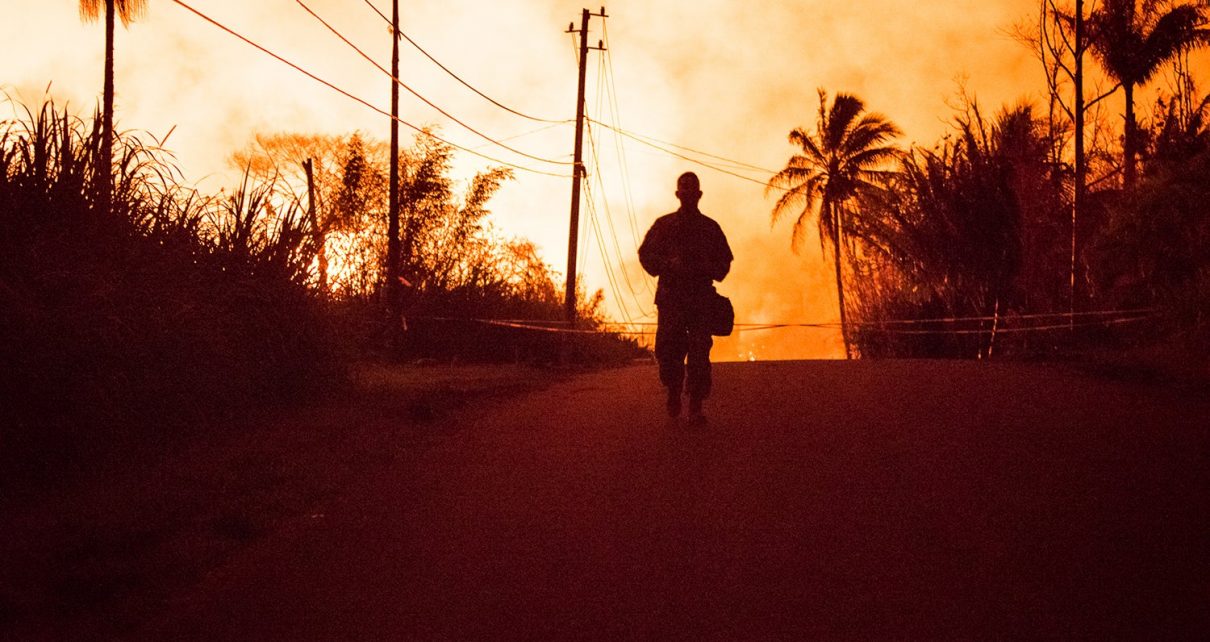On April 30, 2018, the Pu‘u ‘Ō‘ō crater on Hawaii’s Kilauea volcano suddenly collapsed—marking the starting point for its largest eruption in at least 200 years. The lava lake inside another crater drained into the ground. Roughly 60,000 earthquakes struck the region. New fissures ripped open along the volcano’s slopes and poured approximately one billion cubic yards of lava over streets and neighborhoods—enough to destroy 716 dwellings and to build 875 acres of new land. But what sparked the unrest? A controversial new study proposes an unlikely culprit: rainfall.
James Farquharson and Falk Amelung, both volcanologists at the University of Miami, analyzed the amount of precipitation to hit Hawaii in the months leading up to the 2018 eruption and found it was roughly 2.5 times higher than average. That increase could merely be an odd coincidence. But after building computer models to determine how such an onslaught of rain affected the Kilauea system, the duo calculated the water that had seeped into the ground exerted a higher pressure on the surrounding rock than had been seen in the past 50 years. This pressure, they say, could have fractured rock near an underground magma chamber, creating new pathways for the molten rock to rise to the surface—and thus unleashing the volcano’s most destructive eruption in recorded history.
At the very least, the researchers contend, the rainfall could have kicked things into gear—pushing a volcano that was primed for an eruption over the edge. The results of their work, published on Wednesday in Nature, have not yet convinced other experts. “I’m skeptical, but it’s not an idea without merit,” says Michael Manga, a geophysicist at the University of California, Berkeley, who reviewed the study for Nature but was not involved in the work.
For an eruption to occur, magma needs to break free of its chamber and reach the surface. This event can happen when the pressure inside the chamber grows so strong that it breaks the rock walls—or when a secondary mechanism does so. Because Farquharson and Amelung see no evidence that the pressure inside Kilauea’s magma chamber grew just before the 2018 eruption, they argue that such a secondary mechanism—in this case, the groundwater—must have been the deciding factor. They say their model supports that hypothesis, as does rainfall history: when Farquharson and Amelung analyzed all of Kilauea’s reported eruptions since 1790, the researchers found they tended to occur at the wettest time of the year.
Water, after all, is more powerful than it may seem. Last year a study suggested that a spring surge of meltwater caused a swarm of earthquakes near California’s Long Valley Caldera. The same correlation has been suggested at Washington State’s Mount Rainier and Yellowstone National Park’s supervolcano. While rainfall has never been convicted in the case of a volcanic eruption, smaller stresses—even those from the moon’s tidal pull—have been blamed for pushing volcanoes over the edge.
But other experts disagree that rain alone triggered the April 2018 eruption. Michael Poland, a U.S. Geological Survey geophysicist, who has worked extensively on Kilauea and was not involved in the new study, notes that roughly two weeks before the Pu‘u ‘Ō‘ō crater collapsed and the eruption began in earnest, the crater had inflated so drastically that the Hawaiian Volcano Observatory issued a warning that a new vent might be torn open on the volcano’s flank. Magma was likely moving into the system, causing pressure to build toward an eruption. Thus, even though precipitation could have provided the final impetus in triggering the eruption, Poland argues, it was probably not the only culprit. Manga agrees. “If rainfall did play any role,” he says, “at most, it changed the detailed timing of a system poised to change.” The difference in opinion lies largely in the changes produced prior to eruption. Poland notes that the pressurization could be seen across the system, yet Farquharson and Amelung say the inflation measurements were so small and localized that the data do not discount their hypothesis that rainfall was the sole catalyst.
Poland also points to some other possible sticking points for the idea that rain even helped usher the eruption along. When he and his USGS colleagues looked at publicly available rainfall data, he says, they did not see the same spike the new study pointed to. The year 2018 “was wet—no doubt about that,” Poland says, but there were other periods over the past two decades that were even wetter. (Farquharson and Amelung say they have not seen the USGS records and cannot comment on this observation.) Additionally, Poland contends that even if the rain fell in torrents, it might not have made it into the rift zone (linear cracks in the volcano’s surface), because that zone is often barricaded by dikes of hardened magma that are solidified and impermeable—a feature the new model does not include. Farquharson acknowledges these limitations: “It’s fair to criticize the modeling as being simplistic,” he says. Yet he still considers it a valuable starting point for understanding what fueled the eruption. Manga does agree that the authors’ model reasonably handles this issue. He notes, however, that because the rift zone was already hot, any rain that did trickle in might have vaporized before it could exert much pressure on the system.
To definitively answer the question of rainfall’s role, Manga says, scientists will first need to better monitor the groundwater near Kilauea and other active volcanoes. If they can find a clear connection, it might make sense to increase alert levels at volcanoes based on indications from weather reports. But with the current information in hand, Manga argues that rainfall alone does not merit such a policy change—in part because these alert levels have serious ramifications. Just like the rule to shelter in place during the COVID-19 pandemic has had huge economic consequences, he says, raising the alert level on a volcano can have significant local effects. “If you tell people the volcano might erupt, then tourism may dry up, and local residents will get stressed,” Manga says, adding that official responses “should be founded on reliable and robust data, because of the human and economic consequences.”



